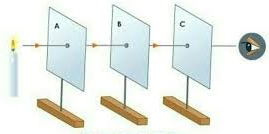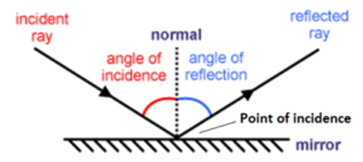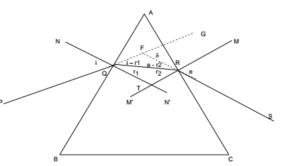Science > Physics > Wave Theory of Light >Photometry and Sources of Light
In this article, we shall study brief history of study of light, sources of light, andterminology of optics.
History of Study of Light:
- Light is a form of that energy which simulates our vision. Around 400 B.C., it was proposed that particles were emitted by eye when the object is seen.
- In 1660 The great British physician Sir Issac Newton proposed Corpuscular theory to explain the propagation of light. He assumed the particle nature of light.
- In 1680, A Dutch (Holand) scientist and contemporary of Newton, Christan Huygens (1629 – 1695) proposed Wave theory of light.
- The rectilinear propagation of light is due to the fact that the wavelength of light may be much smaller than the dimensions of openings and obstacles casting sharp shadows. Due to Newton’s clout on scientists in that era, the Huygens’s wave theory of light remained in a dump for almost century. Newton’s theory was challenged on the basis of Huygens’s wave theory of light by Thomas Young (1773 – 1829) in 1801 using his Double slit experiment.
- These experiments clearly established that light coming from two coherent sources interfere and produce maxima and minima depending upon path difference between the two waves. This phenomenon is known as the interference of light.
- Augustin Jean Fresnel (1788 – 1827) performed a series of experiments to study the diffraction of light and disapproved Newton’s theory and supported Huygens’s wave theory of light.
- The exact nature of light waves was not known, because only mechanical waves were known at that time. For the propagation of mechanical waves, the medium is required. But light waves were found to travel in a vacuum. Hence in 1860 Maxwell proposed that the light are electromagnetic waves and do not require any medium for propagation.
- In 1888 Hertz and in 1900 Hallwachs and Lenard observed that when light falls on the metal surface, electrons are ejected and that the kinetic energy of emitting electrons does not depend on the intensity of light used. This observation is known as the photoelectric effect. This effect was explained by Albert Einstein in 1905 on the basis of the particle model of light.
- Now it is accepted by the scientific community of the world that light has a dual nature particle as well as wave. A particular nature either wave or particle depends on circumstances.
Phenomenon Associated With Light:
Rectilinear Propagation of Light:
Light travels in a straight lines unless it is reflected by a polished surface or the medium of propagation is changed.

Reflection of Light:
When light rays are incident on a polished surface, they are sent back in the same medium such that the angle of incidence is equal to angle of reflection and the incident ray, the reflected ray and the normal at the point of incidence lie in same plane.

Refraction of Light:
When light ray traveling in one optically active medium enters another optically active medium then the light ray deviates from its path. This phenomenon is known as refraction of light.

Diffraction of Light:
When a light wave is obstructed by an obstacle, then the rays round the corner. This phenomenon is called diffraction of light.

Interference of Light:
Light coming from two coherent sources interfere and produce maxima and minima depending upon path difference between the two waves. Thus alternate bright and dark regions can be obtained on the screen kept in the path of the two waves. This phenomenon is known as interference of light.

Polarization of Light:
The electric field in a light wave vibrate in the direction perpendicular to the direction of propagation of the wave. But there are infinite directions which are perpendicular to the direction of propagation of the wave. Thus the wave can vibrate in any plane perpendicular to the direction of propagation of the wave. Such wave is called non polarised wave.
By certain arrangements the non-polarized light wave is made to vibrate in one and only one plane, then the light is called polarised light.

Scattering of Light:
When a parallel beam of light passes through a gas, a part of it appears in directions other than the incident direction. This phenomenon is known as scattering of light.

Spectrum of Light
Visible Spectra:
The part of the spectrum of light which is visible to the human eye is called visible spectra. The frequency of visible light varies from 3.8 x 1014 Hz to 7.8 x 1014 Hz. The corresponding wavelengths are 380 nm and 780 nm.
The colour sensation of the human eye is related to the wavelength of light. The light close to 780 nm appears red and light close to 380 nm appears violet. The human eye is more sensitive to yellow and green light.
Colour Wavelengths: Red (620 – 780 nm) Orange (590 – 620 nm) Yellow (570 – 590 nm) Green (500 – 570 nm) Blue (450 – 500 nm) Violet (380 – 450 nm).

Non Visible Spectra:
Light waves having a wavelength above 780 nm or having a frequency less than 3.8 x 1014 Hz are said to be lying in the infrared region.
Light waves having a wavelength above 380 nm or having frequency more than 7.8 x 1014 Hz are said to be lying in the ultraviolet region.
Characteristics of Light:
- When a monochromatic light travels from one medium to another, its wavelength changes but its frequency remains constant.
- In the electromagnetic waves the angle between electric field vector and magnetic field vector is 90°.
- In the propagation of electromagnetic waves, the angle between the direction of propagation and the plane of polarisation is zero.
- In the propagation of electromagnetic waves, the angle between the plane of vibration and the plane of polarisation is 90°.
- The oscillating electric and magnetic vector of an electromagnetic wave are oriented along mutually perpendicular direction and are in phase.
- Electromagnetic waves transport energy, momentum, information.
- Electromagnetic waves do not carry any charge.Energy of visible light is low (few eV)
Sources of Light:
Sun is major source of light. Some artificial sources of light are as follows
Thermal Sources :
These sources light of all wavelengths in the visible region i.e. having wavelengths in the range from 390 nm to 760 nm. Example: incandescent Bulb, Gas Discharge Tubes. A gas discharge tube emits light of a few wavelengths band. Example: Neon tube gives a characteristic red light.
Luminescent Sources:
These sources emit light partly in the visible region and partly in the ultraviolet region. Example: Fluorescent tube.
Phenomenon of Luminescene:
The phenomenon of emission of light after absorbing some electromagnetic radiations is called luminescene.
Types of Luminescene:
- Electroluminescence: It is a phenomenon of emission of light by electrical means.
- Chemiluminescence: It is a phenomenon of emission of light by chemical reactions.
- Bioluminescence: It is a phenomenon of emission of light by biochemical reactions.
Photometry:
The branch of physics which deals with the measurement of light energy or with the comparisons of illuminating power of the sources or with the comparisons of illumination of the surfaces is called photometry.
Efficiency of Light Source:
When a source of light emits energy, the whole of the radiant energy does not lie in the visible region. A small amount of energy lies in the nonvisible region i.e. infrared and ultraviolet region.
The efficiency of a light source is defined as the ratio of output power in the visible region to the input electrical power.
Luminous flux is measured in lumen (lm) and input electric power is measured in watts (W), hence unit of efficiency of a light source is lumen per watt (lm W-1)
Terminology:
- Optical Medium: The medium capable of transmitting light is called an optical medium.
- Isotropic medium: The homogeneous medium, which has the same properties in all the directions is called an isotropic medium.
- Monochromatic light: A light having one single wavelength is called as monochromatic light (Mono means one and chroma means colour).
- Incident ray: The light ray, which is falling on reflecting or refracting surface is called the incident ray.
- Point of incidence: The point at which the incident ray cuts the reflecting or refracting surface is called the point of incidence.
- Normal: A perpendicular drawn to the surface at the point of incidence is called the normal.
- Angle of incidence: The angle made by the incident ray with the normal at the point of incidence is called the angle of incidence.